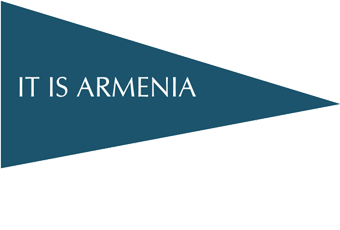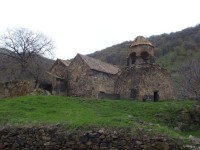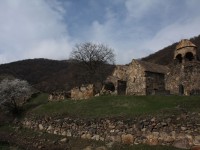Ardvi. Sarbanes Monastery
The village of Ardvi is located in Lori Marz (region), 19 km to the south of the city of Alaverdi. St. Hovhannes Church is located there, which was built by His Holiness Hovhannes Odzneci in the 8th century. His Holiness Hovhannes Odznetsi (718-728) was one of the remarkable figures of Armenian history. He was not only a clergyman, but also politician, cultural activist and scientist. He is the author to many anthems and theological works. One of the most significant works of Odzneci is the “Kanonagirq Hayotz” (Armenian Regulations), the first collection of ecclesiastical law of Armenia. His Holiness Hovhannes Odznetsi was the last of Armenian Catholicoses, who was given the title of saint by the Church. He is also the only Armenian Catholicos who voluntarily resigned from the Patriarchal throne. The great holiness introduced whole his life to the liberation of the Armenian people, to its prosperity and enlightenment. Despite his humble and simple lifestyle, Odznetsi was always elegantly dressed. According to the history, during the reception of the Arab Caliph, caliph seeing his luxurious and splendor outfit shamed him, noting, that it was not appropriate for a Christian clergyman. In response Odznetsi showed goat fur shawl shrouding his body under his outfit and explained that he wore the luxury kit as a sign of authority for only to impress those that are his subordinates. Hovhannes Odzneci was in his time distinguished also by an uncompromising struggle launched against the Pavlikyans. Small monastic complex, that is located in the bosom of the beautiful nature, was built in the 7th century and rebuilt in the 17th century. It consists of two churches and a bell-tower. St. Hovhannes Church is built of large, irregular stones. There is a bell - tower in the neighborhood of the church. Nearby is the cemetery to the Kalantaryans aristocratic family. Commonly, the village belonged to the Kalantaryan Dinasty in the Middle Ages. There are also khatchkars (cross stone), square obelisk and the ruins of economical and residential buildings in the territory of the Monastery. The churches present nave roof covered small halls, which communicate through the input orifice of the total longitudinal wall. The northern Hall, which has horseshoe -shape circular base and square shaped sanctuary, is proportionally smaller than the southern one. Formerly it also had an entrance from the west side, but now it is closed. The compositional elements of the two churches testify that the churches were not built at the same time. The northern Church was built earlier than the whole complex. Probably it was rebuilt during the construction of other buildings of the monastery (presumably in the 17th century). The bell tower was built in the southern part of the monastery in the 17th century. Here is the following explanation of the origin of the name Ardvi: Armenian Commander Vardan Mamikonyan passed through these sites while conducting the raid on Persians to Aghvank. His army frontal regiments were led by his son, who met the Persian army in the area of the village. The valorous son attacked, massacred Persians and ordered to cut off the heads of the killed. When the commander with the main forces reached, his son told him about the battle and reported that he had killed thousands of Persians. But his father did not believe. At that moment the insulted son threw the Persians’ heads at his father's feet and said: take and count. According to another version, the villagers emigrated from the city of Artvin in the early Middle Ages. There is also a third version, according to which the village was once called Melikgyugh. When His Holiness Hovhannes Odzneci left the village Odzun, cursed the village and coming to the village Melik, he said: “Artvi, which ment I Bought Melik and gave Odzun”. Commonly, according to the history Hovhannes Odzneci did not like the village Odzun for the Catholicos was all the time serpentined by the villagers and he left annoyed saying that there were poisonous people living there. Artvin is also known under the name of Snake’s umbilicus. A beautiful legend is referred to this name, according to which a woman met a huge boa constrictor on her way and asked Hovhannes Odzneci for help. Odzneci first sent his seven disciples to help. But they went and did not return, becoming the victims of the snake. Finally, the Saint himself went against the snake. He won the snake with a prayer; then stroked the dragon's head by the rod and said: "Let the healing water go out of your umbilicus. And thus it happened. To this day, the source of healing water springs out of the beautiful rock. According to another tradition, when Odznetsi was serving a liturgy in the village of Ardvi, a dragon creped down from the nearby mountain with great noise and started to go to the village. Hearing the cries of the people, His Holliness Hovhannes signed of the cross on his way from the window, and the dragon stagnated on the spot. At that moment His Holiness picked up Seghbestros’s St. Mark which was presented to Grigor Lusavorich (Gregory the Illuminator) by Pontiff of Rome and hit the dragon with the rod on his other hand. By the power of the St. Mark and the prayers of the saint the dragon stagnated. A black color stone stratum still remains attached to the rock in a horizontal position. Healing water spouts from the place that was hit with the rod. Here in the territory of the monastery was starred the S. Pharadjanov’s film “The Color of the Pomegranate”


















